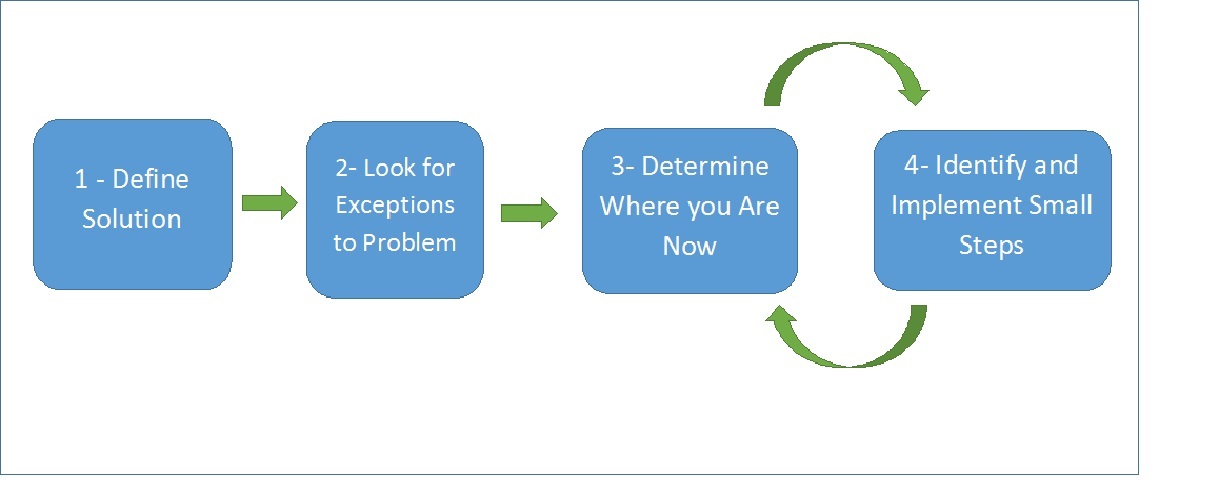A Solution Focused Approach to Solving Life Problems
September 24, 2018 | Uncategorized | 2 Comments
If you are attempting to deal with some life problems or achieving personal goals then a solution focused approach might be helpful. This practical and realistic approach might be exactly what you need. Read on for more details and some ways to utilise this approach.
What is a Solution Focused Approach
Solution Focused Therapy originated in the 70s and was considered at the time to be a radically different way of working with clients with problems. The client could still talk about the problem, but therapy quickly moved into finding solutions. The thinking behind this was that aside from the practical benefit of finding and implementing a solution, and more importantly exceptions to the problem, it also provided increased focus and attention to what was working. The net result was a greater sense of hope, and access to the client’s strengths and resources.
This same approach can be taken outside of therapy when wishing to make progress in a particular part of life. This is particularly the case when conventional goal setting approaches have not worked. Maybe you have not been able to visualize yourself in the post solution state. Or maybe you have been stuck in that sense of not making progress and find yourself unmotivated to continue.
Types of problems / solutions it works best with
- Personal goals that require changes in beliefs and behaviour that are within your control.
- Subjective goals where it is hard to be specific in defining what the end goal is. Use of the miracle question enables you to define what if would be like if the goal was achieved (i.e I want to feel happier about myself / my life, I want to be fitter, I want to have a job that I enjoy etc)
The Process

The key steps in the process are:
1 -Define the solution – Imagine and visualise
A good question to ask yourself is called the miracle question. If you woke up tomorrow and the problem had gone way, and the solution was in place, what would be different. How would you be able to tell. Imagine what you would be like. Who would be in your life and what you would be doing. The more detail you can come up with the better as this will help you in the subsequent steps.
2 – Identify Exceptions to the Problem – Does part of the solution exist now
Are there times where part of the solution visualized in step 1 exists. We are often so focused on the problem that we don’t notice when parts of the solution exists. This steps in the process allows you to look notice times or elements of your life where parts of the solution exists. It provides hope.
Maybe if your goal is to be happier are there parts of some days when this is the case. If your goal is to enjoy your work maybe there are some parts of your work that you do enjoy.
3 – Where am I now
Use a scale of 0-10. Where are you now on believing the problem can be solved. Where are you now on the scale of having the solution. These questions give visibility to your motivation levels as well as a sense of how far you are away from the solution.
Examples:
On a scale of 0 to 10, where 0 is where none of the preferred solution exists, and 10 is where it completely exists, where are you?
On a scale of 0 to 10, where 0 is where you have no hope that you can get to the preferred solution, and 10 is where you are absolutely sure you can, where are you?
4 – What would small progress look like
What would one step further on the hope or progress scale look like?. What would you need to do? Can you do this? This process embodies the idea that progress is made in small achievable steps. Both hope and progress are tracked. If hope is very low, initial steps can be focused on increasing hope.
Examples:
(If you are on 2 on progress). What would it take to be one step further, say a 3 on progress towards your goal of enjoying work ?
(if you are 0 on hope). In your hope of being able to be happier in your relationship, what would need to happen for you to feel say a 1, that this is possible?
Steps 1 and 2 are the focus of the beginning of the process, whereas steps 3 and 4 become the focus as you start to make progress. As you can see from the diagram, you cycle between steps 3 and 4 until the solution is achieved and the problem does not exist.
Caution
For those suffering from trauma and / or mental health issues. If a goal or solution is outside of your control then this approach may just cause you additional distress. If this is the case, or if you are not sure what would represent something you can work on, then I suggest consulting a mental health professional.
In finishing
A solution focused approach draws on powerful tools such as visualizing and imagination to arrive at a preferred solution, particularly for goals which aren’t so clear cut. It then take a strengths approach to implementing the solution by making progress in small and achievable steps.
Related articles:
The Role of Hope in Goal Achievement